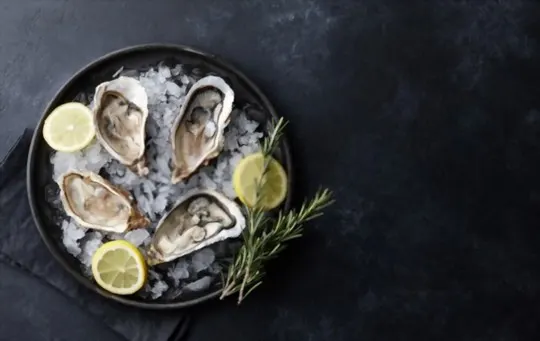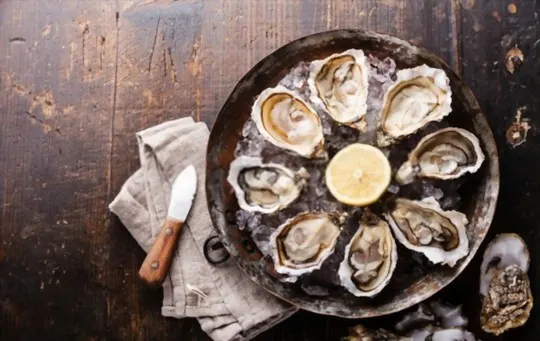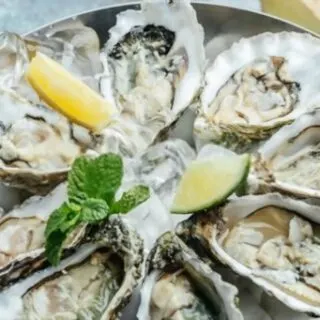Are you curious to know what oyster tastes like?
Whether you are someone who enjoys trying new types of food, or looking for a tasty seafood option, this article will provide you with all the necessary information.
You will discover the flavor profile, various preparation methods and accompanying sauces that will make this seafood delicacy even more irresistible.
Get ready to experience something truly delicious.
What is Oyster?

Oysters are saltwater mollusks that are highly valued for their delicate taste and firm texture.
Oysters possess a complex flavor profile that is described as briny, tangy, slightly metallic, and slightly sweet.
The taste of oysters can be influenced by a variety of factors, including the species, growing location, and growing conditions.
Some oysters have a milder and sweeter taste than others, while others are more assertive and briny.
Oysters are also known for their unique texture, which ranges from soft and creamy to firm and chewy, depending on the variety.
Raw oysters are often served on the half shell and can be accompanied by lemon juice, horseradish, or hot sauce.
Cooked oysters can be grilled, fried, or used in soups and stews.
What Does Oyster Taste Like?

Oysters have a unique taste that is difficult to describe.
They are known for their briny, salty flavor and smooth, buttery texture that melts in your mouth.
Different oyster varieties have varying levels of sweetness, umami, and minerality, depending on where they are harvested.
Raw oysters are often served with lemon wedges or a mignonette sauce to complement their flavor.
When cooked, oysters take on a firmer texture and can have a slightly sweet, nutty taste.
However, cooking oysters also changes their texture, making them less desirable to some seafood lovers.
If you’re curious about oysters but hesitant to try them, start with a mild-tasting variety like Kumamotos or Pacific oysters to ease into the flavor.
Factors that Affect the Taste of Oysters

The taste of oysters can be affected by various factors, including their species, environment, and the way they are prepared.
- Species: Different species of oysters have distinct flavor profiles. For example, Pacific oysters tend to have a buttery and metallic taste, while Atlantic oysters are briny and have a mineral flavor.
- Environment: The environment in which oysters grow can affect their taste. Oysters grown in saltier water are typically brinier, while those grown in more freshwater taste sweeter.
- Preparation: The way oysters are prepared can also impact their taste. Raw oysters are often enjoyed with lemon and hot sauce, while grilled or fried oysters have a more smoky and savory flavor.
Other factors like harvest time, freshness, and storage can also influence the taste of oysters.
To fully appreciate the taste of oysters, try consuming them at different times of the year, from different locations, and with different accompaniments to explore their versatile flavor profiles.
1 – Species and Origin
Oysters have a unique taste that varies by species and their origin, influenced by the water where they are grown.
- Briny oysters: These oysters are usually harvested from the Atlantic coast and have a salty taste with a metallic aftertaste.
- Sweet oysters: These oysters are typically grown in the Pacific and have a mild and sweet flavor with a slightly fruity finish.
- Umami oysters: These oysters are grown in the West Coast of North America and have a savory and buttery flavor profile.
- Coppery oysters: These oysters have a mineral-like taste resembling copper or iron and are found in the Gulf of Mexico.
- Salty oysters: These oysters have a salty and briny flavor found in the East Coast regions of the United States.
Raw oysters are best enjoyed with a squeeze of lemon, hot sauce, horseradish, or mignonette sauce to enhance the flavor.
2 – Size and Age
When it comes to oyster taste, size and age are important factors to consider.
Generally, the larger the oyster, the more intense its flavor.
Here’s what you need to know about oyster taste based on their size and age:
- Small oysters: They tend to have a milder taste with a briny, slightly sweet flavor. These are ideal for first-time oyster eaters who are not accustomed to the strong taste of oysters.
- Medium oysters: They have a slightly stronger taste than the small ones, with a more pronounced briny flavor.
- Large oysters: These are the most intense in flavor, with a complex taste that is briny, metallic, and slightly sweet.
Age also affects oyster taste, with younger oysters being milder and older ones having a more robust taste.
Nonetheless, the taste of an oyster is subjective and varies depending on personal preferences.
3 – Season and Harvesting Location
The taste of oysters can vary depending on the season and harvesting location.
In general, oysters have a briny and slightly sweet flavor with a tender and gelatinous texture.
The taste can also change depending on the type of oyster with some having a more metallic taste or a creamy texture.
The season and harvesting location can also play a significant role in the taste of oysters.
For example, oysters harvested during the winter months may have a more robust and saltier flavor due to the colder water temperature, while oysters from warm waters have a milder taste.
It’s also essential to note that over-harvesting can impact the flavor of oysters as they feed on phytoplankton, and changes in water quality can change the taste of the oysters grown there.
To get the most from the oyster, consume it raw or grilled, and avoid pairing it with strongly flavored foods or drinks.
4 – Preparation Method and Accompaniments
When it comes to preparing and consuming oysters, simplicity is key.
Raw oysters are a popular choice and can be enjoyed as is or with a variety of accompaniments.
Here are some preparation methods and accompaniments that pair well with oysters:
Preparation methods:
- Raw: Freshly shucked oysters are often consumed raw on the half-shell, accompanied by lemon wedges, cocktail or mignonette sauce.
- Grilled: Grilling oysters over an open flame brings out their natural sweetness and imparts a smoky flavor.
- Fried: Battered and fried oysters are a popular menu item in Southern cuisine.
Accompaniments:
- Lemon wedges: This classic accompaniment enhances the briny flavor of oysters with its acidic tang.
- Cocktail sauce: A blend of ketchup, vinegar, horseradish, and Worcestershire sauce, cocktail sauce adds a spicy kick to raw oysters.
- Mignonette sauce: Made of finely chopped shallots, vinegar, and pepper, mignonette sauce provides a tangy counterpoint to the natural saltiness of oysters.
- Hot sauce: A few drops of hot sauce add a fiery kick to raw oysters, and pairs well with beer and other alcoholic beverages.
Nutritional Value of Oysters

Oysters are packed with beneficial nutrients that make them a delicacy beyond their taste.
They are high in protein and also contain other essential nutrients such as vitamins and minerals that support various bodily processes.
One six-piece serving size of raw Pacific Oysters contains:
- Calories: 58-70.
- Zinc: 102% of the RDI.
- Vitamin B12: 324% of the RDI.
- Copper: 200% of the RDI.
- Vitamin D: 56-80% of the RDI.
- Iron: 44-72% of the RDI.
- Selenium: 44-56% of the RDI.
As far as the taste goes, it can be challenging to describe the taste of an oyster, as it can vary based on species, location, and method of preparation.
However, most people describe them as having a slightly salty and briny flavor that is best enhanced with a squeeze of lemon juice.
How to Eat Oysters
Oysters have a flavor profile that is unique, with a texture and taste that is highly sought after.
Their taste can vary depending on the species, the region, and the method of preparation.
Here are some key characteristics of the taste of oysters:
- Briny: Oysters have a salty, ocean-like flavor due to their natural habitat in seawater. The brininess can vary depending on the species and the region where they were harvested.
- Sweet: Some species of oysters have a sweet flavor with a subtle aftertaste. This is often the case with oysters that are farmed in areas with a lot of freshwater inflow.
- Umami: Oysters have an umami flavor, which is the fifth taste sensation often described as savory or meaty.
- Metallic: Some oysters have a metallic taste that can be off-putting to some people. This is often caused by certain minerals or compounds in the water where they were grown.
- Creamy: Oysters have a unique texture that can be described as creamy, especially when eaten raw.
Try a variety of oysters to find out which flavor profile you prefer.
The way oysters are prepared also has a large effect on their taste, so experiment with cooking methods as well.
Variations of Oyster Dishes Around the World
Oysters have a unique taste that can be described as briny, savory, and sometimes metallic.
The texture is soft and slippery, with a chewy finish.
Oysters are often served raw or cooked in various dishes, and there are many variations of oyster preparations around the world.
Here are a few examples:
- Oysters Rockefeller – A classic American dish made with oysters baked with spinach, butter, garlic, and breadcrumbs.
- Kilpatrick Oysters – A popular Australian recipe that involves grilling oysters with Worcestershire sauce, bacon, and cheese.
- Oysters Mornay – A French dish made with oysters baked with a rich Mornay sauce made of cheese, milk, and butter.
- Oyster Omelette – A Taiwanese street food made with eggs, oysters, and vegetables like shallots and cilantro.
No matter how oysters are prepared, their unique taste and texture make them a delicacy enjoyed by many around the world.
Where to Buy Oysters and How to Store Them?

Oysters have a distinct taste characterized by a sweet, salty flavor, and a texture that’s both chewy and slippery.
Buying fresh oysters and storing them properly is key to enjoying the best flavor and texture.
When purchasing oysters, look for reputable fish markets or online stores known for selling high-quality seafood.
Always opt for oysters that are kept cold and properly packaged to ensure freshness.
When storing oysters, place them in a bowl with a damp towel covering them, and store them in the refrigerator.
Do not store oysters in airtight containers, as they need to breathe.
To determine whether an oyster is fresh, give it a tap, and it should close its shell tightly.
If it doesn’t, discard it.
When shucking oysters, be sure to wear protective gloves as the shells can be sharp.
With these tips, you’ll be able to indulge in the delicious taste of oysters without worry.
Conclusion
In conclusion, oysters have a unique, briny taste with a slightly sweet finish, which can vary depending on the species, location, and harvest season.
Raw oysters are best served chilled on a bed of ice with lemon wedges, hot sauce, and diced shallots for a flavor-enhancing experience.
Grilled, baked, or fried oysters usually have a milder taste and a firmer texture that complements well with sauces or as a component of a seafood dish.
Whether you’re an oyster lover or trying them for the first time, exploring different cooking methods and pairing options can add depth to your culinary journey.
Remember, freshness is key when it comes to enjoying seafood, especially oysters.

What Does Oyster Taste Like? A Comprehensive Guide
Ingredients
- Oyster
- Ingredients from your selected recipes
Instructions
- Select your favorite ingredient from the range available in this article.
- Collect all the necessary items to make the recipe.
- Use the instructions provided to prepare a delicious dish in 30 minutes or less.

Carrie is a food writer and editor with more than 15 years of experience. She has worked for some of the biggest names in the food industry, including Bon Appétit, Food & Wine, and Martha Stewart Living.
As the Editor in Chief of IntroChicago.com, Carrie oversees all of the content on the site. She also manages the team of contributing writers and editors, who help to create delicious recipes, helpful tips, and informative articles that you’ll find on the site.
A native of the Chicago area, Carrie is passionate about all things food. She loves trying new restaurants and experimenting with new recipes in her kitchen. She’s also a graduate of the Culinary Institute of America, so she knows a thing or two about food!
